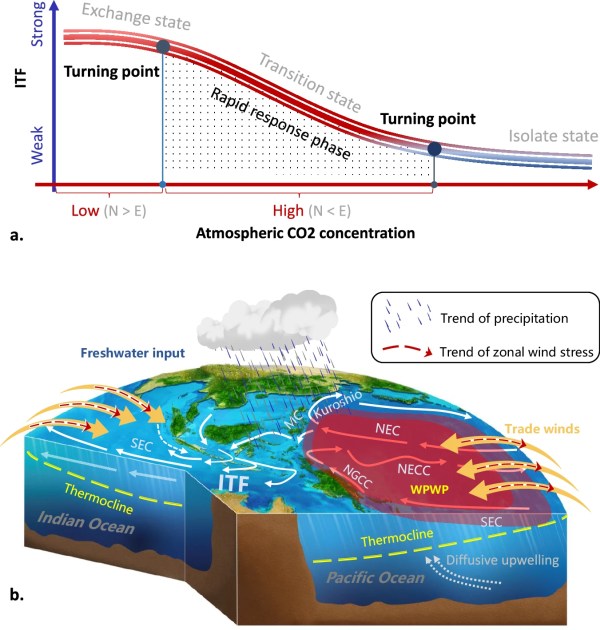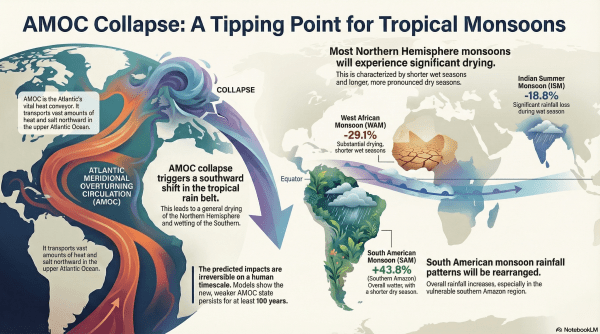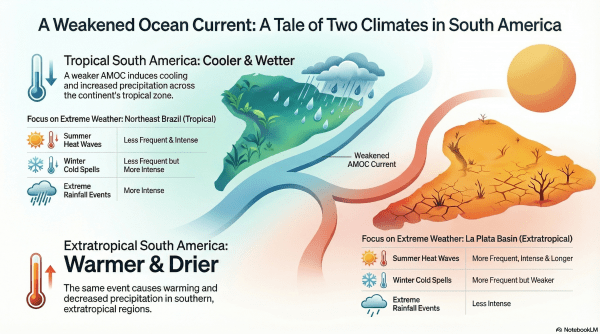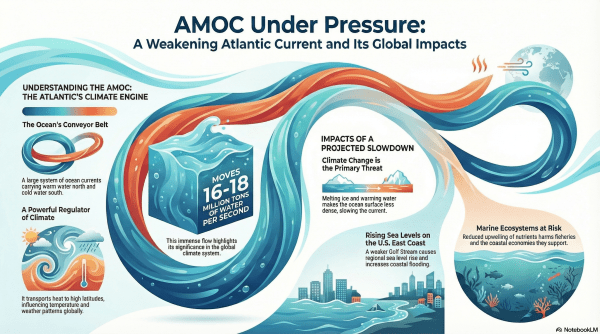This blog post and the “Deep Dive” podcast, created by NotebookLM, are based on “Imminent rapid decline of the Indonesian Throughflow after reaching a turning point of CO2 concentration" by Hu et al. (2025). This research article analyzes how rising carbon dioxide levels affect the Indonesian Throughflow (ITF), a vital oceanic link between the Pacific... Continue Reading →
A Collapse Of The AMOC Would Drastically Alter Global Monsoons
This blog post and the “Deep Dive” podcast, created by NotebookLM, are based on “Impacts of AMOC Collapse on Monsoon Rainfall: A Multi‐Model Comparison” by Ben-Yami et al. (2024). Summary: Ben-Yami et al. (2024) analyzes how a potential collapse of the Atlantic Meridional Overturning Circulation (AMOC) would drastically alter tropical monsoon rainfall patterns worldwide. By... Continue Reading →
How a Weakening Atlantic Ocean Circulation Is Rewriting South America’s Weather
This blog post and the “Deep Dive” podcast, created by NotebookLM, are based on “Impacts of a Reduced AMOC on the South America Mean Climate and Extremes” by Meccia & Blázquez (2025). Summary: This study investigates how a weakening Atlantic meridional overturning circulation (AMOC) influences the climate and weather extremes of South America. Utilizing the EC-Earth3 climate... Continue Reading →
More Than an Emission: How Rising Waste Heat Are Cooking North America
This blog post and the “Deep Dive” podcast, created by NotebookLM, are based on “Energy‐Consumption‐Induced Anthropogenic Heat Release Intensifies Heatwaves and Wildfire Threats in North America: A CESM2‐Based Projection for the Late 21st Century” by Wang et al. (2025). When we talk about climate change, the conversation almost invariably turns to greenhouse gases. Carbon dioxide,... Continue Reading →
Why Rising Seas Could Lower a Hurricane’s Peak Surge—But Drown a Wider Area
This blog post and the “Deep Dive” podcast, created by NotebookLM, are based on “Combined impacts of hurricane strengthening and global mean sea level rise on future Atlantic storm surge events” by Danso et al. (2025). It’s a scenario that seems frighteningly straightforward: as climate change causes sea levels to rise and hurricanes to strengthen,... Continue Reading →
The Atlantic’s Weakening Pulse: How a Slowing Ocean Current Could Reshape Our Climate and Coasts
This blog post and the “Deep Dive” podcast, created by NotebookLM, are based on "State of the Science Fact Sheet: Atlantic Meridional Overturning Circulation (AMOC)" by NOAA Science Council. This NOAA fact sheet briefly explains the Atlantic Meridional Overturning Circulation (AMOC), defining it as a critical ocean current that transports heat, salt, and carbon by... Continue Reading →
TWISO is a tropics-wide 45-day pulse and does not requires MJO
This blog post and the “Deep Dive” podcast on a paper “Tropics-wide intraseasonal oscillations” by Bao et al. (2025) was created by NotebookLM. Deep Dive Podcast “Earth's Global Climate Heartbeat The TWISO Cycle” powered by NotebookLM: 1.0 Introduction: The Stable Tropics Aren't So Stable When we think about the climate of the tropics, we tend... Continue Reading →
The Atlantic’s Slowing “Heartbeat”: How a Fading Ocean Current Is Silencing a Major Climate Pattern
This blog post and the “Debate” podcast on a paper “Atlantic Meridional Overturning Circulation slowdown suppresses Atlantic Niño variability” by Freire-SouzaLi et al. (2025) was created by NotebookLM. Debate Podcast: This is different from Deep Dive Podcast. This is a debate between two hosts, illuminating different perspectives on the study, “Meltwater or Warming Drives Atlantic... Continue Reading →
The Atlantic’s ‘Warming Hole’ Isn’t What You Think: 5 Surprising Truths From New Climate Research
This blog post and the "Deep Drive" podcast on a new paper "Atmosphere-driven processes in shaping long-term climate variability in Greenland and the broader subpolar North Atlantic" by Li et al. (2025) was created by NotebookLM. Deep Dive Podcast "The Wind-Driven Mystery of the North Atlantic Warming Hole: How Atmospheric Swings Orchestrate Ocean Heat and... Continue Reading →
Seasonal outlook of hurricane activity for five North Atlantic sub-basins
Seasonal hurricane outlooks, such as those issued by NOAA's Climate Prediction Center, Colorado State University (Klotzbach et al., 2017), European Center for Medium-Range Weather Forecasts, and University of Arizona (Davis and Zeng, 2019), produce skillful (i.e.,. better than climatology) seasonal forecasts of overall North Atlantic tropical cyclone (TC) activity. Such forecasts are possible because seasonal... Continue Reading →










